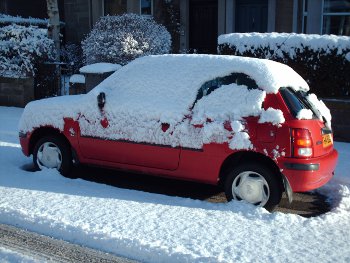
Don’t be one of those idiots who just scrapes a ‘porthole’ clear on the windscreen and drives along peering through it, unable to see anything around them. Clear the windscreen and the side windows completely before driving off.
Based on the view out of my window this morning, cold winter weather finally seems to be arriving in the UK — and with it the icy mornings and evenings that catch out so many drivers each year.
The traction problems caused by snow and ice can be reduced by using winter or all-season tyres, but even if you use these cold weather-rated tyres on your own car, you will find that virtually all hire vans in the UK come with ‘standard’ summer tyres.
These provide very little grip in snow or ice — not ideal if you’re driving an unfamiliar hire van laden with your personal possessions or a valuable delivery of business goods.
Driving tips for icy conditions
With the help of Peter Rodger, who is the Institute of Advanced Motorist’s chief examiner, I’ve put together six key tips for driving safely in icy conditions. By following these tips, you can reduce the chance of being involved in a cold weather-related crash and keep your van, and yourself, safe.
- Keep to main roads where possible, as they’re more likely to be salted. Also bear in mind that after the frost has gone, ice can remain in areas which are shaded by trees and buildings – and it forms there first, so be careful in the evening as the temperature drops.
- It may seem obvious to say, but every year people forget to make sure that they have de-icer and a scraper in their vehicles. If you’re driving a hire van you’ll need to provide your own, so make sure you have a spare or ‘borrow’ them from your car. Whatever you do, don’t be one of those people who only scrape a small area of glass clear and drive along looking through a slit – clear the whole windscreen to be able to see properly, otherwise you are a danger to yourself and other road users.
- If the road is slippery when you start off, do it in second gear, releasing the clutch and accelerating gently, avoiding high revs – this will help prevent wheel spin. As you drive, stay in higher gears to help avoid wheelspin.
- It seems obvious, but cars and vans go in ditches every winter because drivers haven’t taken icy roads seriously enough. If it’s cold outside, treat wet looking patches with great care – they could be ice, not water.
- Stopping distances are increased by up to 10 times in icy conditions, so leave plenty of distance between your van and the vehicle in front – plan so that you’re not relying on your brakes to stop, as they may not have any effect in icy conditions. If it is really slippery, slow down early, and use the gears to do it.
- If your van loses grip and starts to slide sideways, take your foot off the accelerator, and point the front wheels where you want to go.
Rodger is keen to emphasise that your attitude and mental preparation are key to staying safe on the roads in winter conditions:
“Being mentally prepared as well as having the right equipment is vital, so think about any problems you encountered last winter, and what you need to do to avoid them or overcome them if they recur this year.”
I agree, and suspect that many drivers get into trouble in winter conditions because they simply don’t know — and haven’t ever been taught (or learned) the correct way to drive in snow and ice.
Rodger’s tips make a great starting point, and I’d strongly recommend you read through them a couple of times to ensure that you know what to do when you are faced with an icy road or snowy conditions on a journey you can’t avoid.
